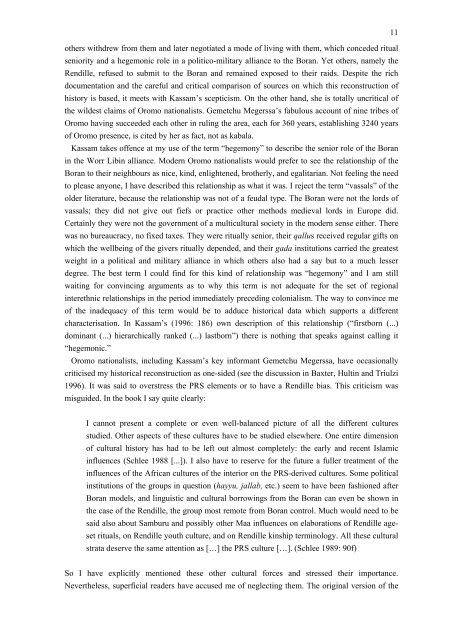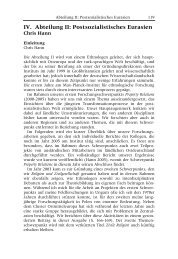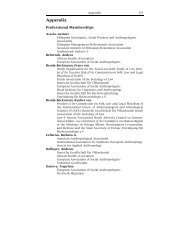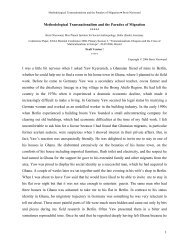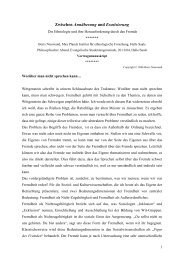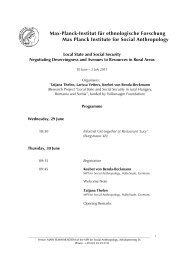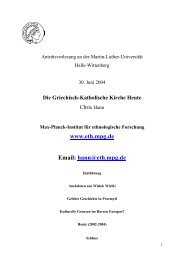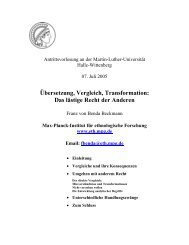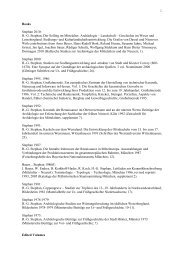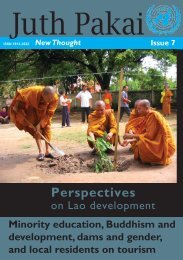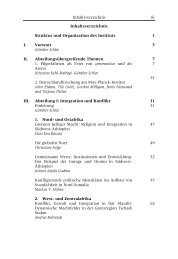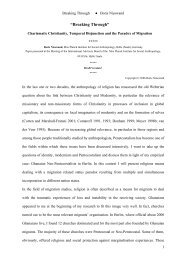ETHNOPOLITICS AND GAbRA ORIGINS - Max-Planck-Institut für ...
ETHNOPOLITICS AND GAbRA ORIGINS - Max-Planck-Institut für ...
ETHNOPOLITICS AND GAbRA ORIGINS - Max-Planck-Institut für ...
You also want an ePaper? Increase the reach of your titles
YUMPU automatically turns print PDFs into web optimized ePapers that Google loves.
others withdrew from them and later negotiated a mode of living with them, which conceded ritual<br />
seniority and a hegemonic role in a politico-military alliance to the Boran. Yet others, namely the<br />
Rendille, refused to submit to the Boran and remained exposed to their raids. Despite the rich<br />
documentation and the careful and critical comparison of sources on which this reconstruction of<br />
history is based, it meets with Kassam’s scepticism. On the other hand, she is totally uncritical of<br />
the wildest claims of Oromo nationalists. Gemetchu Megerssa’s fabulous account of nine tribes of<br />
Oromo having succeeded each other in ruling the area, each for 360 years, establishing 3240 years<br />
of Oromo presence, is cited by her as fact, not as kabala.<br />
Kassam takes offence at my use of the term “hegemony” to describe the senior role of the Boran<br />
in the Worr Libin alliance. Modern Oromo nationalists would prefer to see the relationship of the<br />
Boran to their neighbours as nice, kind, enlightened, brotherly, and egalitarian. Not feeling the need<br />
to please anyone, I have described this relationship as what it was. I reject the term “vassals” of the<br />
older literature, because the relationship was not of a feudal type. The Boran were not the lords of<br />
vassals; they did not give out fiefs or practice other methods medieval lords in Europe did.<br />
Certainly they were not the government of a multicultural society in the modern sense either. There<br />
was no bureaucracy, no fixed taxes. They were ritually senior, their qallus received regular gifts on<br />
which the wellbeing of the givers ritually depended, and their gada institutions carried the greatest<br />
weight in a political and military alliance in which others also had a say but to a much lesser<br />
degree. The best term I could find for this kind of relationship was “hegemony” and I am still<br />
waiting for convincing arguments as to why this term is not adequate for the set of regional<br />
interethnic relationships in the period immediately preceding colonialism. The way to convince me<br />
of the inadequacy of this term would be to adduce historical data which supports a different<br />
characterisation. In Kassam’s (1996: 186) own description of this relationship (“firstborn (...)<br />
dominant (...) hierarchically ranked (...) lastborn”) there is nothing that speaks against calling it<br />
“hegemonic.”<br />
Oromo nationalists, including Kassam’s key informant Gemetchu Megerssa, have occasionally<br />
criticised my historical reconstruction as one-sided (see the discussion in Baxter, Hultin and Triulzi<br />
1996). It was said to overstress the PRS elements or to have a Rendille bias. This criticism was<br />
misguided. In the book I say quite clearly:<br />
I cannot present a complete or even well-balanced picture of all the different cultures<br />
studied. Other aspects of these cultures have to be studied elsewhere. One entire dimension<br />
of cultural history has had to be left out almost completely: the early and recent Islamic<br />
influences (Schlee 1988 [...]). I also have to reserve for the future a fuller treatment of the<br />
influences of the African cultures of the interior on the PRS-derived cultures. Some political<br />
institutions of the groups in question (hayyu, jallab, etc.) seem to have been fashioned after<br />
Boran models, and linguistic and cultural borrowings from the Boran can even be shown in<br />
the case of the Rendille, the group most remote from Boran control. Much would need to be<br />
said also about Samburu and possibly other Maa influences on elaborations of Rendille ageset<br />
rituals, on Rendille youth culture, and on Rendille kinship terminology. All these cultural<br />
strata deserve the same attention as […] the PRS culture […]. (Schlee 1989: 90f)<br />
So I have explicitly mentioned these other cultural forces and stressed their importance.<br />
Nevertheless, superficial readers have accused me of neglecting them. The original version of the<br />
11


